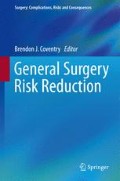Abstract
Humans work within systems in a particular setting or environment. As such, there are numerous factors governing performance, outcomes and risk, with the operational elements often termed 'human factors', 'system factors' and 'environmental factors'. In this Chapter we concentrate on risk and its relationship with these principal factors, and the evaluation of these.
Access this chapter
Tax calculation will be finalised at checkout
Purchases are for personal use only
Further Reading, References and Resources
ACSQHC. Ensuring correct patient, correct site, correct procedure protocol for surgery: review of implementation and proposals for action. The Australian Commission on Safety in Healthcare, Australian Government Publishers. 2008. http://www.safetyandquality.gov.au/wp-content/uploads/2012/02/19793-ReviewCPCSCP.pdf.
Australian Institute of Health and Welfare 2007. A national picture of medical indemnity claims in Australia 2004–05. AIHW cat. no. HSE 48. Canberra: AIHW.
Anderson M. Risk management – its working!!! Medical Insurance Group Australia (MIGA) Bulletin; June 2007, p. 1–2. Available at www.miga.com.au. Refer to the tables provided. Further analysis published in the MIGA Annual Reviews 2009 and 2010.
AS/NZS ISO 31000:2009. Risk management – principles and guidelines. November 2009. ISBN: 0-7337-9289-8. http://www.iso.org/iso/catalogue.
AIHW 2007. Australia’s welfare 2007. Australia’s welfare no. 8. Cat. no. AUS 93. Canberra: AIHW. http://www.aihw.gov.au/publication-detail/?id=6442468047. Viewed 7 Nov 2013.
Braddock 3rd CH, Fihn SD, Levinson W, Jonsen AR, Pearlman RA. How doctors and patients discuss routine clinical decisions. Informed decision making in the outpatient setting. J Gen Intern Med. 1997;12(6):339–45. PubMed PMID: 9192250; PubMed Central PMCID: PMC1497128.
Chapanis A. Human factors in systems engineering. New York: Wiley; 1996.
Clever SL, Jin L, Levinson W, Meltzer DO. Does doctor-patient communication affect patient satisfaction with hospital care? Results of an analysis with a novel instrumental variable. Health Serv Res. 2008;43(5 Pt 1):1505–19.
Fitzgerald E. Human factors engineering in healthcare. MIGA Bulletin; August 2008. Available at www.miga.com.au
Gaba DK, Howard SK. Fatigue among clinicians and the safety of patients. New Engl J Med. 2002;347(16):1249–55.
Goodwin H. Litigation and surgical practice in the UK. Br J Surg. 2000;87:977–9.
Haynes K. Interpersonal performance. Br J Hosp Med. 2007;68(3):120–1. Review.
Hendrick, K. Is tort reform enough risk management? Medical Insurance Group Australia (MIGA) Bulletin; December 2008, p. 6. Available at www.miga.com.au
Hendrick, K. MIGA’s practice self assessment – what are they telling us?. Medical Insurance Group Australia (MIGA) Bulletin; June 2009, p. 7. Available at www.miga.com.au
Levinson W. Doctor-patient communication and medical malpractice: implications for pediatricians. Pediatr Ann. 1997;26(3):186–93. PubMed PMID: 9084055.
Levinson W, Roter DL, Mullooly JP, Dull VT, Frankel RM. Physician-patient communication. The relationship with malpractice claims among primary care physicians and surgeons. JAMA. 1997;277(7):553–9. PubMed PMID: 9032162.
MIGA. June 2007 Bulletin; p. 1–2. Available at www.miga.com.au
MIGA. 2009 Annual review; p. 19; MIGA annual review; p. 18. Available at www.miga.com.au
MIGA. 2010 Annual review. Available at www.miga.com.au
Moorthy K, Munz Y, Adams S, Pandey V, Darzi A. A human factors analysis of technical and team skills among surgical trainees during procedural simulations in a simulated operating theatre. Ann Surg. 2005;242(5):631–9.
National Health and Medical Research Council (NHMRC). General guidelines for medical practitioners on providing information to patients. 1992, 175 CLR 479 at 483
Reason J. Human error: models and management. Br Med J. 2000;320:768–70.
South Australia Consent to Medical Treatment and Palliative Care Act 1995 section 15 Medical practitioner’s duty to explain Version: 1.7.2010. http://www.legislation.sa.gov.au/lz/c/a/consent_to_medical_treatment_and_palliative_care_act_1995/current/1995.26.un.pdf.
Standards Australia – SAI Global Risk Management AS:/NZS 4360:2004. www.saiglobal.com/shop/script/Details.asp?DocN=AS0733759041AT.
Stewart RM, Johnston J, Geoghegan K, Anthony T, Myers JG, Dent DL, et al. Trauma surgery malpractice risk – perception versus reality. Ann Surg. 2005;241(6):969–77.
Trumble SC, O’Brien ML, O’Brien M, Hartwig B. Communication skills training for doctors increases patient satisfaction. Clin Gov Int J. 2006;11(4):299–307.
Vincent C, Moorthy K, Sarker SK, Chang A, Darzi AW. Systems approaches to surgical quality and safety – from concept to measurement. Ann Surg. 2004;239(4):475–82.
Wickens CD, Gordon SE, Liu Y. An introduction to human factors engineering. New York: Addison Wesley Longman; 1998.
Yule S, Flin R, Paterson-Brown S, Maran N. Non-technical skills for surgeons in the operating room: a review of the literature. Surgery. 2006;139(2):140–9.
Acknowledgements
The authors would like to thank Medical Insurance Group Australia (MIGA) for their help and assistance in providing some thoughts and data from their claims research from their novel efforts in developing interactive risk management programs (IRM) for their members.
Author information
Authors and Affiliations
Editor information
Editors and Affiliations
Rights and permissions
Copyright information
© 2014 Springer-Verlag London
About this chapter
Cite this chapter
Thomas, M., Phillips, I.C., Coventry, B.J. (2014). Risk Management and Human Factors. In: Coventry, B. (eds) General Surgery Risk Reduction. Surgery: Complications, Risks and Consequences. Springer, London. https://doi.org/10.1007/978-1-4471-5391-7_9
Download citation
DOI: https://doi.org/10.1007/978-1-4471-5391-7_9
Published:
Publisher Name: Springer, London
Print ISBN: 978-1-4471-5390-0
Online ISBN: 978-1-4471-5391-7
eBook Packages: MedicineMedicine (R0)

